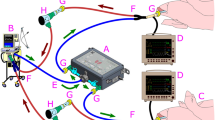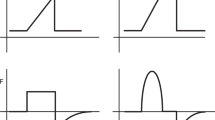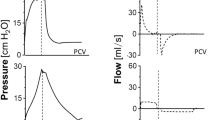Abstract
Recognition that volume, not pressure, is the key factor in ventilator-induced lung injury and awareness of the association of hypocarbia and brain injury foster the desire to better control delivered tidal volume. Recently, microprocessor-based modifications of pressure-limited, time-cycled ventilators were developed to combine advantages of pressure-limited ventilation with the ability to deliver a more consistent tidal volume. Each of the modes has advantages and disadvantages, with limited clinical data available to judge their effectiveness. The Volume Guarantee mode has been studied most thoroughly and is the only one that provides automatic weaning of peak pressure in response to improving lung compliance and patient respiratory effort. More consistent tidal volume, fewer excessively large breaths, lower peak pressure, less hypocarbia and lower levels of inflammatory cytokines have been documented. It remains to be seen if these short-term benefits will translate into shorter duration of ventilation or reduced incidence of chronic lung disease.
This is a preview of subscription content, access via your institution
Access options
Subscribe to this journal
Receive 12 print issues and online access
$259.00 per year
only $21.58 per issue
Buy this article
- Purchase on Springer Link
- Instant access to full article PDF
Prices may be subject to local taxes which are calculated during checkout


Similar content being viewed by others
References
Dreyfuss D, Saumon G . Ventilator-induced lung injury: lessons from experimental studies. Am J Respir Crit Care Med 1998;157:294–323.
Clark RH, Slutsky AS, Gertsmann DR . Lung protective strategies of ventilation in the neonate: what are they? Pediatrics 2000;105 (1):112–114.
Graziani LJ, Spitzer AR, Mitchell DG, et al. Mechanical ventilation in preterm infants. Neurosonographic and developmental studies. Pediatrics 1992;90:515–522.
Fujimoto S, Togari H, Yamaguchi N, Mizutani F, Suzuki S, Sobajima H . Hypocarbia and cystic periventricular leukomalacia in premature infants. Arch Dis Child 1994;71:F107–F110.
Wiswell TE, Graziani LJ, Kornhauser MS, et al. Effects of hypocarbia on the development of cystic periventricular leukomalacia in premature infants treated with high-frequency jet ventilation. Pediatrics 1996;98:918–924.
Okumura A, Hayakawa F, Kato T, et al. Hypocarbia in preterm infants with periventricular leukomalacia: the relation between hypocarbia and mechanical ventilation. Pediatrics 2001;107 (3):469–475.
Luyt K, Wright D, Baumer JH . Randomised study comparing extent of hypocarbia in preterm infants during conventional and patient triggered ventilation. Arch Dis Child Fetal Neonatal Ed 2001;84:F14–F17.
Cannon ML, Cornell J, Tripp-Hamel DS, et al. Tidal volumes for ventilated infants should be determined with a pneumotachometer placed at the endotracheal tube. Am J Respir Crit Care Med 2000;162:2109–2112.
Castle RA, Dunne CJ, Mok Q, Wade AM, Stocks J . Accuracy of displayed values of tidal volume in the pediatric intensive care unit. Crit Care Med 2002;30:2566–2574.
Piotrowski A, Sobala W, Kawczynski P . Patient-initiated, pressure-regulated, volume-controlled ventilation compared with intermittent mandatory ventilation in neonates: a prospective, randomised study. Intens Care Med 1997;23 (9):975–981.
D’Angio CT, Chess PR, Kovacs SJ, et al. Assist-control ventilation in infants 500–1250 grams’ birthweight does not decrease time to extubation when compared to synchronized intermittent mandatory ventilation: a randomized controlled trial. Pediatr Res 2003;53:367A.
Abubakar KM, Keszler M . Patient–ventilator interactions in newer modes of mechanical ventilation. Pediatr Pulmonol 2001;32:71–75.
Cheema IU, Ahluwalia JS . Feasibility of tidal volume-guided ventilation in newborn infants: a randomized, crossover trial using the volume guarantee modality. Pediatrics 2001;107:1323–1328.
Herrera CM, Gerhardt T, Claure N, et al. Effects of volume-guaranteed synchronized intermittent mandatory ventilation in preterm infants recovering from respiratory failure. Pediatrics 2002;110:529–533.
Keszler M, Abubakar KM . Volume Guarantee: stability of tidal volume and the incidence of hypocarbia. Pediatr Pulmonol 2004;38:240–245.
Abubakar KM, Keszler M . Volume Guarantee is more effective when combined with Assist/Control ventilation than with synchronized intermittent mandatory ventilation (SIMV). Pediatr Res 2004;55:532A.
Lista G, Colnaghi M, Castoldi F, et al. Impact of targeted-volume ventilation on lung inflammatory response in preterm infants with respiratory distress syndrome (RDS). Pediatr Pulmonol 2004;37 (6):510–514.
Acknowledgements
Some of the research referred to in this paper was partially supported by a research grant from Draeger Inc.
Author information
Authors and Affiliations
Additional information
Disclosure: Research support was from Discovery Laboratories, Draeger Inc., Pfizer Inc. Consultant: Bunnel Inc., Draeger Inc. Speakers bureau: INO Therapeutics.
Rights and permissions
About this article
Cite this article
Keszler, M. Volume-Targeted Ventilation. J Perinatol 25 (Suppl 2), S19–S22 (2005). https://doi.org/10.1038/sj.jp.7211313
Published:
Issue Date:
DOI: https://doi.org/10.1038/sj.jp.7211313
This article is cited by
-
Tidal volume delivery during surfactant administration in the delivery room
Intensive Care Medicine (2011)
-
Volume-targeted modes of modern neonatal ventilators: how stable is the delivered tidal volume?
Intensive Care Medicine (2007)



